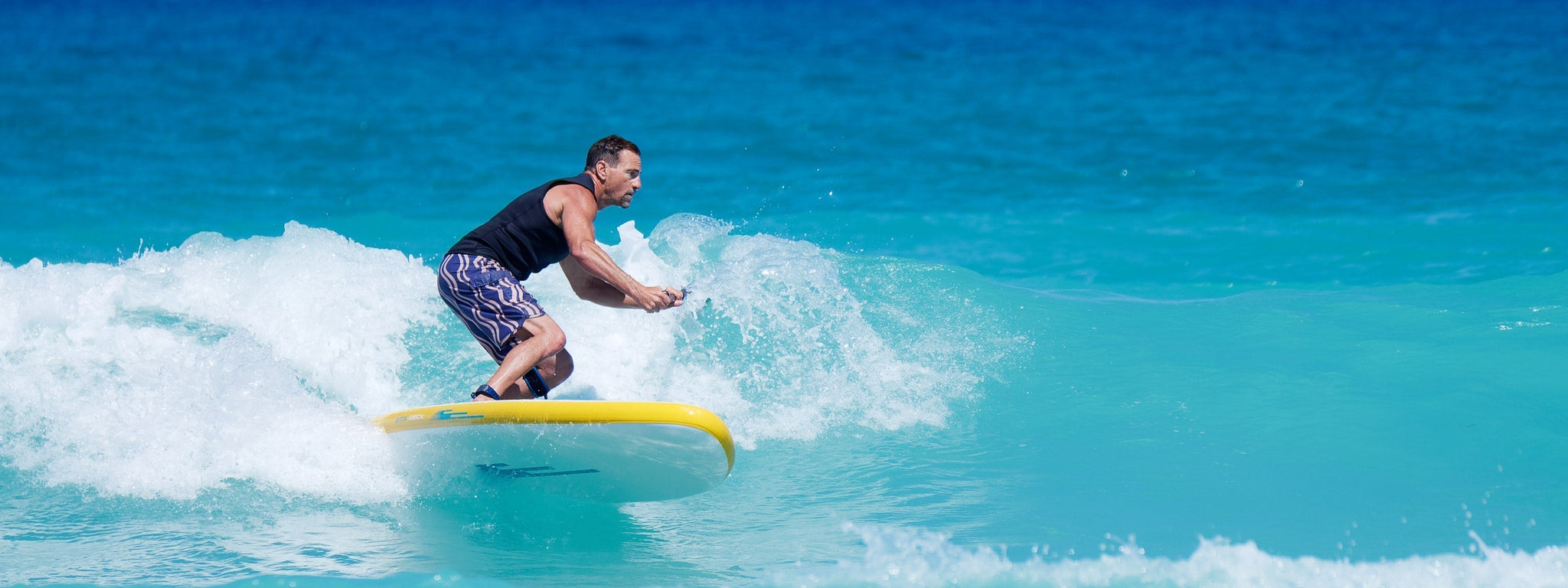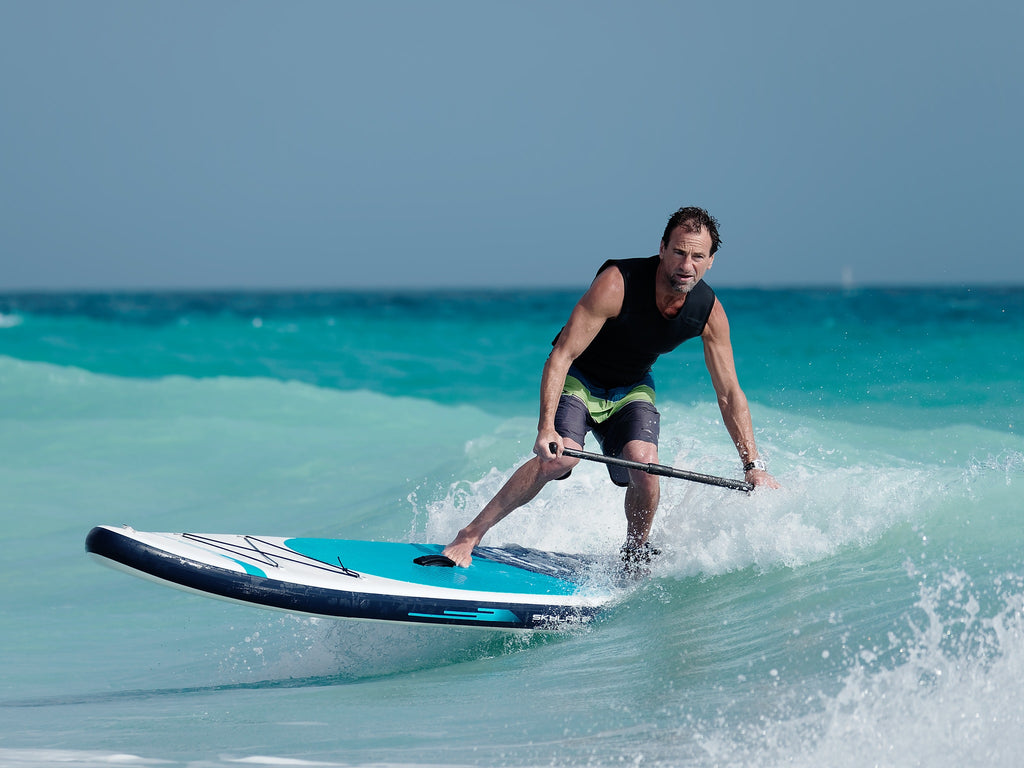
5 Questions to Ask Before Buying a SUP Surfing Board
Planning to Buy a SUP Board For Surfing?
Whether you are a seasoned surfer or someone who has always wanted to give surfing a try, stand up paddle boarding is a natural way of getting into the waves.
Standing upright on a board gives you an elevated vantage point for seeing the incoming waves, your paddle helps you get in the ideal position for catching the wave, and there is advantage in the fact that you are already standing when the wave approaches.
If you’re getting on in years, you might appreciate that it is a little easier on the body than traditional surfing and can be a more approachable way of having fun in the ocean.
How do you choose the best paddle board for surfing? The truth is that you can surf on almost any paddle board, but some will perform better than others. If surfing will be your main SUP activity, you’ll want a board specialized for surfing, but if it is something you want to dabble in when opportunities arise, a board with more varied uses will make the most sense.
Before choosing a board, ask yourself these 5 questions:

1. Is The Board Shape Ideal For SUP Surfing?
There are really two ways to go when choosing a board shape for SUP surfing. If surfing will be the main purpose of the board and you plan on owning a second board for other paddling types, then you should consider a surf-specific design.
If only one SUP board is in the cards for you and you want something that will let you have a great time catching waves but also keep you happy paddling in various non-surf venues, you should go with an all-around board shape that is also amenable to surfing.
Specialized SUP surfing boards are short - usually less than 9ish feet in length - and have relatively low volume compared to boards used for general paddling. Some inflatable boards have only 4 inches of thickness, which is now considered too thin for most paddle boards, as 5 and 6-inch boards with greater stiffness has become the norm.
The lower volume of a surf-specific board can enhance performance on some waves where the board will be skimming over the water surface instead of relying on the inherent buoyancy of the board, and the thinner rails of a 4-inch thick board may enhance turning performance in certain conditions.
Some surfing paddle boards have a very narrow tail to make the board more responsive to foot pressure when turning. The factors that make these boards work well for surfing - short length, low volume, reduced thickness, and narrow tails - also make them less suitable for other types of paddling where more length and volume are needed.
For surf-specific hard boards (usually shortboards), the principles of design between a surfboard and a SUP used for surfing are similar enough that you will probably have a good idea of the type of shape you prefer. A hard board SUP can be shaped and tuned for the types of waves or break you want to be riding, so the option of having it built to an exact specification is a potential option.
All-Around SUP Boards for Surfing
All-around SUP boards, if chosen correctly, can double very nicely as a surfing SUP while still being an ideal board for everyday paddling. The key to choosing a versatile board that will do well for you in the surf is to find the sweet spot of length, width, and thickness that checks off all the boxes for you. Go with a length at the short end of your recommended range, a width in the middle range, and a thickness that gives you enough buoyancy to glide efficiently on flat water.
In general, for an all-around board that will also be used in the surf, a rider weighing less than 160 lb should consider a 5 inch thick board in the 9’6” length range, a rider under 180 should look in the 9’6” to 10’8” range for a 5” board as an all-around alternative. Paddlers over 200lb who benefit from more flotation should consider a 5 inch or 6-inch thick board of 10 feet or longer depending on the type of waves you want to ride.
Riders with surfing experience can go with smaller and shorter boards than beginning surfers and will usually have a pretty good idea of the shape they require. This, as a general rule, will get you closer to a surfing 'feel', but choosing a larger board is also OK if you want something to use in other water environments. It will just handle a little differently and be more challenging as the waves get bigger.
Another option in up to knee high surf can be a touring board, which you would control like a longboard but mostly staying in a straight line. You are not going to whip turns on it, but a reasonably stable touring board can be a lot of fun in surf for riding small waves and can provide a great option for pushing through the break and confidently exploring the deeper water behind it.

All-around boards with the right feature set can be tuned for waves, and give you the option of getting out on the water regardless of the surf report. Featured Product - ERS Deck 10-7 S3
2. How Will The Fin Setup Help Me In and Out of the Surf?
While the dimensions and shape of a board are the first factors to consider when choosing a board, the fin setup can let you tune - and sometimes really transform - the performance of the board.
The most basic fin setup for a surfing SUP is a single long center fin. Having just one fin in the center creates the least drag and works well on boards that are optimized for surfing, hard boards in particular.
On inflatable paddle boards, the rails are more rounded and contribute less to carving performance than the narrower rails of a hardboard, so some additional assistance from the fins is crucial.
Side Fins for Control
Adding side fins alongside the center fin contributes to the rider’s ability to control the tail of the board in the absence of hard rails that would otherwise contribute to carving performance. For this reason, we recommend a board that lets you add side fins when you need the extra traction, but has the flexibility of being used with a single center fin when speed is your priority.
A permanent three-fin setup will also get the job done, but with a little less flexibility in terms of tuning your ride. Permanent fin setups have the advantage of never losing a fin or breaking the fin box.
Harder fins are often favored in pure surfing for more control, but with inflatable SUP surfing you won’t be riding perfect barrels where the rigidity of the fins will critically impact the performance of the board. A fin with a little flex will perform fine in most wave environments, so have fun, experiment and don’t sweat the black art of fin selection.
Pure surfing is a thrill and obsession, and when the conditions are right we will rack up a surfboard and see you in the lineup. For other times when mother nature isn’t providing, it doesn’t stop us going out and riding whatever is out there. For this reason, we think inflatables have several advantages in stand up paddle board surfing on waves that are poor to average from a pure surfing perspective.

Larger center fins have more hold, shorter center fins create a looser feel. These are usually relative to the board size but for surfing an inflatable SUP a single 4.5" center fin is a good starting point. This will give you a good feel for the board physics then you can add side bites for assistance or a larger center fin.
There is no right answer when it comes to your fin setup so experimenting and knowing how your board feels with alternate setups will allow you to tune it better for different waves and conditions.
3. Is the Deck Pad Ideal For Surfing?
As with any type of SUP board, the quality and texture of the deck pad on a SUP surfing board makes a big difference in traction and on how the board feels underfoot. In general, a thicker and longer deck pad that covers more board surface is a good thing because there will be a tendency to fall on various parts of the board especially while learning to surf, but for the most part you will be switching into surfer stance and to your rear foot for control.
If you will be surfing your SUP, look for a board with a contoured tail pad area with a raised rear edge to keep your back foot from sliding off the board and to give you more leverage when applying foot pressure.
A feature that is very helpful but available on fewer boards is a raised arch bar at the tail of the deck pad that lets you feel where your back foot is situated without having to look down. An arch bar (or T bar), allows you to dig your rear foot in and apply weight into the board to pivot the tail and lean back into the board. The arch bar is also use to trim the board where you alternate weight between the ball and heel to assist in tilting the rail, and it also provides a tactile reference of the board center line when in surfer stance.
When SUP surfing you will change stances and hop, or slide positions on the board depending on your position relative to the wave you're riding. Moving between the mid section, where you will paddle to gain speed and momentum, toward rear of the board, where you will use your weight and back foot to initiate turns and adjust direction.
It's not unusual to shift positions a few times during a wave from closeout to reforming depending on the conditions and your skill level. The movements and shifts when surfing need be instinctual, so utilizing the features of your deck pad and knowing the ins and outs of the standing area of your SUP is important.

An arch support bar and raised tail pad are important features for an inflatable SUP in the surf.
An arch bar is a small rectangular shaped bump at the rear of the deck pad that allows you to position your heel or ball of the foot either side and push your weight into the board. The kick pad allows you to dig in when bracing over wash in rough surf and lean your bodyweight back to control direction through a wave.
4. Should I Buy an Inflatable or Hard Board for SUP Surfing?
If pure SUP surfing is your thing, a hardboard has some distinct performance advantages over an inflatable. The most obvious is that shape of the rails, which are considerably more sculpted on a hardboard and more amenable to surfing maneuvers.
It will feel closer to a surfboard and it's going to give you more speed on the wave, and more control when turning and making direction adjustments. On the other hand, traveling with a hard SUP board can be an expensive and inconvenient proposition, in which case your choice in some cases may be between surfing an inflatable or not surfing at all.
Inflatables are easier to travel with, and this will open up many more opportunities and different environments to catch waves.
Inflatables also have their own advantages for surfing. Beginners will appreciate the softer landing when falling onto the board and lighter impact when the board inevitably gets flipped onto your head after you get worked. Much of the time learning to surf will be spent on your knees, which will be far more comfortable on the softer surface of an inflatable.
If surfing will only be an occasional thing for you, the convenience and performance advantages of an inflatable SUP in other conditions and types of water will outweigh the technical advantages of a hardboard in the surf.

Interested in a SUP board for use in waves and surf? - we work with surfer and paddle surfers ongoing and can help you assess the pros and cons of inflatable SUP boards designed for uses in waves. We're confident we can put you on the best SUP board for surfing.
How Are Inflatable SUP Boards Different for Surfing?
The larger volume of an inflatable can make paddling out a little more challenging, though reading water is something that comes with a lot of experience even for very good surfers. Pick your spot between waves, paddle hard and don't get discouraged if you paddle into a breaking wave on occasion and get bumped from your board. Duck dives are not an option so learning how to brace while standing and paddling out will be highly useful, as is knee and prone paddling.
Prone paddling will be more difficult on a SUP board compared to a surfboard, because they are generally wider, and you have to secure your paddle by placing it under your chest, and get it away from you if you get caught near breaking waves. Prone paddling can be useful though to give your other muscles a break and an important skill to get underneath wind.
Learning to brace over incoming waves standing is the best way to get good at SUP surfing. It's a lot of fun once you realize the challenge of bracing over a wave can be almost as much fun as catching one and it breaks up your session nicely.
Adjustments and Practice
Most inflatable SUP boards, especially all-around boards, are going to be larger compared to the average surf specific hard board design. The initial challenge on most boards will be speed, and staying in the wave though you have the advantage of using a paddle that can give a quick burst of acceleration. This will be the biggest adjustment, especially if you're coming from a surfing background. The muscle memory built up over the years is going to need refining from shifting your weight, through to actually doing something with your hands in both holding, and using a paddle effectively.
It takes practice to ride waves on an inflatable, just as it takes practice to become a good surfer. You can not just transfer surfing skills straight away you need a little time to learn how to deal with a bigger board and how to stay ahead of it. It isn't going to get the same drive, it isn't going to cutback sharply, but it is going to be a fun challenge and it will give you a really different and unique style of surfing.
The Best Paddle Board for Surfing
The best SUP for surfing, is the one you actually get out on. Don't be the guy or girl who spends hours with crossed arms surveying the break, driving up and down the coast talking about it while waiting for perfect conditions that are not coming. Even when the waves are not great you can still have fun on an all-around inflatable.
We’ve spent many hours on days where we couldn’t use our surfboards due to poor wave conditions just charging breaks, riding closeout waves, and exploring deep water coastline. If you're a surfer who knows that feeling of disappointment when the surf report and cameras are showing red, a performance inflatable will get you on the water regardless.

Class leading short boards are a lot of fun on waves. Compact, all around SUP boards that excel in surf are shaped to turn fast and provide good stability for a wide range of wave types. Featured Product - ERS SKYLAKE 9-6 S3
5. Am I Getting The Best Value With My SUP Surfing Board Choice?
A well-designed and built inflatable SUP is a significant investment, so you’ll want to make sure to choose wisely and get a board that will get you having fun on the water as much as possible.
If you will be surfing frequently, it makes sense to consider a surf-specific board and have a second board for other types of paddling. If surfing will be one of many things you want to do on your board, we recommend choosing an all-around board that has the right shape and features to perform for you when there are waves to catch.
With those basics under your belt, come see our selection of the best inflatable paddle boards for SUP surfing.

Want Expert Advice on Choosing an Inflatable SUP Board?
Check out our 2025 Inflatable Paddle Board Buying Guide - or - The Best Inflatable Paddle Board - Reality vs the Internet.
Want To Buy an Inflatable SUP Board?
Explore our range of SUP boards for sale by activity / use in Inflatable SUP Type or focus on Inflatable SUP Brands to find the right board for you.
Want Answers to Anything Stand Up Paddle Boarding and Inflatable SUP?
The Pumped Up SUP SUP Paddle Blog is the best resource on the internet for up to date information to help with your next inflatable SUP purchase!




